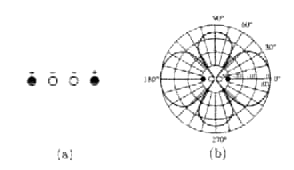"On the sound field radiated by a tuning fork" Am. J. Phys., Vol. 68, No. 12, 1139-1145, December 2000 . To quote:
Dan Russell has also produced a prize-winning website of animations relevant to teaching 'vibrations and waves'.Unfortunately, those older texts which attempt to explain the sound field close to the fork do so in terms of constructive and destructive interference effects. This would seem an implausible explanation since the tines of a tuning fork are almost always separated by a distance much smaller than half a wavelength of the sound emitted, which means that interference effects should be noticed only at significant distances from the fork tines. Sillitto7 has shown that close to the fork it is path-length-dependent amplitude differences which determine the sound field and that path-length-dependent phase differences only become dominant at large distances from the fork.[7 R. M. Sillitto, "Angular distribution of the acoustic radiation from a tuning fork" Am. J. Phys. 34, 639–644 1966]
He writes to us: "Richard's 1966 AJP paper on tuning forks provided the impetus for my experimental investigations."
On the other hand, Google and MSN searches for 'tuning fork' give as the first hit a colourful prize-winning presentation by a Norwegian schoolboy who decided that the "assumption and formula for the intensity" made by "an old physicist by the name Richard M. Sillitto" was "only correct due to the distance (R), but not to the angle (q)".
